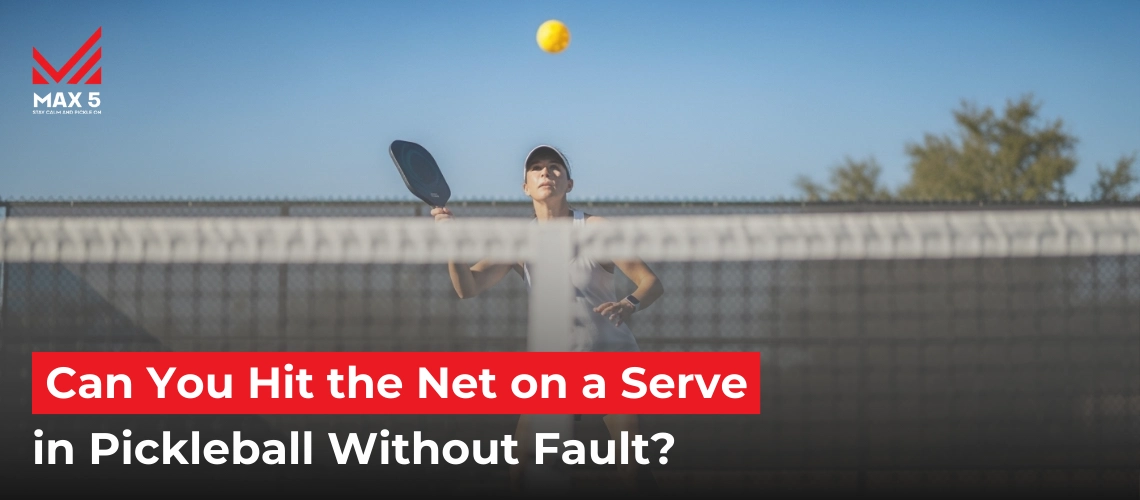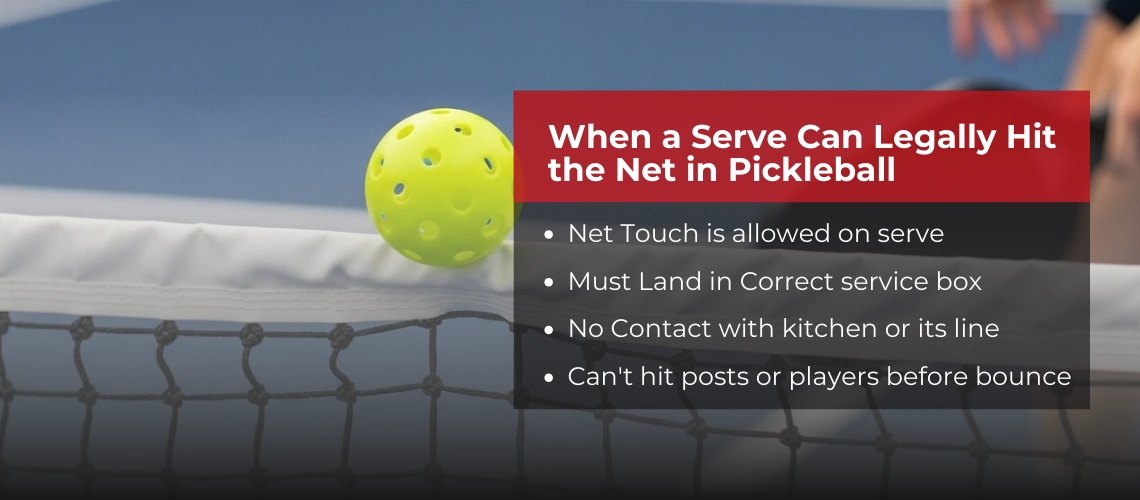
Can You Hit the Net on a Serve in Pickleball Without Fault?
A clean serve sets the foundation of casual or tournament matches, but what if it grazes the net? Many players coming from tennis get confused as to why there’s no penalty for hitting the ball on a net during serving. There’s a catch, yes, you can hit the net on a serve in pickleball, but only if it clears the net and lands crosscourt, beyond the non-volley zone, inside the sidelines and baseline.
Tennis players call it “let serve,” and what used to be called a “let” is now playable under 2025 USA Pickleball rules. We’ll break down legal vs. fault serves, explain net interactions during play, and clarify what’s changed. To make sure the pickleballs you are practicing with have consistence flight over the net, try MX PRO Pickleballs (available in 6-pack or 3-pack).
Are Players Allowed to Hit the Net on a Serve in Pickleball?
Yes, you can hit the net on a serve in pickleball if the ball lands legally. Under the updated USA Pickleball rules, there’s no longer a “let” call for net serves. The ball remains live as long as it clears the net and lands in the correct crosscourt service area, beyond the kitchen. See when it’s “legal” and when it’s a fault, so there’s no confusion while you’re mid-rally.
When a Serve Can Hit the Net (Still Be Legal)
It’s a valid serve if the ball hits the net and goes over, assuming:
- The ball may graze the net cord and still land in the correct diagonal service box.
- It lands beyond the kitchen (non-volley zone) and does not touch the kitchen line
- It touches the baseline, sideline, or centerline within the correct service box
- The contact is only with the net, net cord, or rope between posts (not the posts themselves)
- The ball doesn’t pre-bounce hit the receiver, or their partner
When these conditions are met, play continues without interruption. This rule removes ambiguity and keeps rallies flowing. It is especially helpful during fast-paced games.
When a Net Serve Is a Fault
It’s ruled a fault when the serve hits the net and:
- Contacts the NVZ (kitchen) or its boundary line.
- Misses the service court entirely (too long, wide, or short)
- Rebounds back to your side after hitting the net
- Hits the net post, side structure, or anything outside the playable net zone
- Hits the receiver or their partner before bouncing off the ground
In these cases, the serve ends immediately. You’ll either switch servers or lose the rally, depending on your team’s rotation.
Pro Tip for Pickleball players!
Don’t overthink a slight net graze. As long as the ball drops where it should, keep playing. Want consistency in how your serves behave after brushing the net? Use a tournament-grade ball like the MX PRO Pickleballs, available in 3-pack and 6-pack for players who care about bounce, feel, and durability.
Understanding Pickleball Let Serve
Historically, a let serve in pickleball means a serve that hits the net, clears it, and lands in the opponent’s diagonal service box. Similar to tennis, this used to result in a replay. However, as of the 2022-2023 USA Pickleball Rulebook, the term “let” is no longer used and has no official standing.
Now, are there lets in pickleball? Technically, no, not in the rulebook. But the scenario still exists: a serve hits the net and lands correctly. Unlike tennis, there is no second chance. There is no interruption or pause. The rally continues immediately if the serve is legal.
Why the Pickleball Let Serve Rule Changed
Before 2022, players were required to stop play and replay any let serve. Over time, this created unnecessary stoppages and subjective arguments. To keep matches moving, USA Pickleball removed the let rule. Now, if a pickleball serve hits the net and goes over but lands in, it’s live, no debate.
This rule has improved the pace of play and minimized on-court confusion, especially in competitive or social settings.
Pickleball vs Tennis Let Serve
Scenario | Tennis | Pickleball (Post-2022) |
Serve hits net, lands in correct box | Replay the serve | Play continues |
Serve hits net, lands outside service box | Fault | Fault |
Serve hits net, hits net post | Fault | Fault |
Serve hits net, hits opponent directly | Let or fault depending on timing | Fault if it hasn’t bounced |
Mention of “let” in rulebook | Yes | No |
So, what happens if the ball hits the net in pickleball? If it still drops into the correct diagonal service box, it’s fair game. The word “let” may linger in casual conversation, but by rule, it’s just another live serve, so keep playing.
Want to understand how a pickleball court compares to a tennis court in size and layout? Check out this detailed guide of Max5’s experts.
Pickleball Net Rules Explained With Real-Game Scenarios
Understanding what happens when the ball, paddle, or player interacts with the net is important for players taking part in tournaments. Here’s what most of our common net interactions mean. We have covered around the net, over the net, under the net, and even hand contact with direct rule interpretations.
1. Ball Touches Net Mid-Rally: Is It Legal?
Yes, a ball can graze or clip the net during a rally as long as it lands in bounds. We’ve seen how awkward these shots look due to bounces or low returns, especially in kitchen exchanges. No matter how awkward it is, remember the rule is simple:
- “During a rally, net contact does not result in a fault if the ball is in the opponent’s court.”
This includes service returns and volley battles near the non-volley zone. So, can the pickleball hit the net during a rally? If it clears and lands inside the lines, the point continues.
2. Mastering the Around-the-Net Shot (ATP)
An around-the-net shot, also known as an ATP (Around The Post), is completely legal and incredibly satisfying to pull off. The official rule allows players to send the ball around the net post without crossing over the actual net.
- “The return is legal if it goes outside the net post and lands in, even if it travels under net height.”
These shots are common when a ball is hit sharply crosscourt and bounces far outside the sideline. Instead of going over the net, you can angle your paddle and shoot the ball around the post (a trick to catch your opponent off guard!). Timing and court awareness are crucial here.
Can you hit around the net in pickleball? Yes, and it might be one of the most strategic winners you hit all match.
3. Reaching or Touching the Net: What’s Allowed?
You can reach over the net, but only in a very specific situation:
If the ball bounces on your side and then spins or drifts back to your opponent’s side untouched, you are allowed to break the plane of the net to hit it. However, any physical contact with the net, post, or opponent’s court is an immediate fault.
- Real match example: Your opponent hits a backspin drop shot. It bounces on your side and starts spinning back. You lean over and flick it while the ball is still in play. As long as you didn’t touch the net or the opponent’s court, the shot is valid.
Can you reach over the net in pickleball? Only if the ball spins back and you avoid all net contact. Otherwise, it’s a fault.
4. What If the Ball Goes Under or Through the Net?
If the ball travels under the net or through the side post area, it’s a fault. The net is designed to prevent any legal play from crossing below or outside its structure.
- A ball hitting the net support post is considered out.
- If a shot goes under the net or through any side opening, the point is over.
Can the ball go under or through the net in pickleball? No, those scenarios always result in a fault.
5. What Happens If You Hit the Ball With Your Hand?
In some cases, hand contact is legal, but only if you’re holding the paddle and the ball contacts below the wrist. This can happen during fast volleys or deflections at the net.
For example, if a ball ricochets off your paddle hand during a block and you’re still gripping the paddle below the wrist, it’s allowed. Any contact with the ball on the upper body or paddle hand (above wrist) is a fault.
- “As long as contact is below the wrist and the paddle is in hand, rally continues.”
Other notes:
- Catching the ball mid-air is a fault, even if it’s heading out.
- You can legally switch hands or hit two-handed shots.
- “Carry” hits are allowed if it’s one continuous motion.
What Is the Official Rule on a Let Serve in Pickleball (2025)?
Under the updated 2025 USA Pickleball Rulebook, let serves no longer exist. However, serve rules still exist, and they are strict. Here’s a quick table showing when a violation is called a fault or replay under both officiated and non-officiated play, for volley and drop serves.
Rule Reference | Violation Description | Officiated Play – Referee Not Certain | Officiated Play – Referee Certain | Non-Officiated Play – Receiver Determines |
VOLLEY SERVE | ||||
4.A.7.a | No upward arc on serve | Replay | Fault | None |
4.A.7.b | Paddle head above wrist | Replay | Fault | None |
4.A.7.c | Contact above waist | Replay | Fault | None |
4.A.5 | Spin imparted | Replay | Fault | Replay |
4.A.6 | Release not visible | Replay | Replay | Replay |
DROP SERVE | ||||
4.A.8.a | Ball not dropped unaided or with one hand only | Replay | Fault | None |
4.A.8.b | Ball propelled up/down (not dropped naturally) | Replay | Fault | None |
4.A.5 | Spin imparted | Replay | Fault | Replay |
4.A.6 | Release not visible | Replay | Replay | Replay |
Final Tips on Net Contact & Safe Play
So, to answer “can you hit the net on a serve in pickleball,” yes, but with boundaries. A serve that touches the net is legal only when it lands past the kitchen and within the diagonal service box.
If it lands short, touches the net post, or enters the NVZ, it’s a fault. For serious play, try USAPA-approved balls like MX PRO Pickleballs. Practice pickleball flight strategies with clean bounce, solid control, and no dead spots.
Frequently Asked Questions
What if the ball touches the net post or a permanent object?
If a ball hits the net post or any permanent object (like fences or lights), it’s immediately ruled dead. That’s a fault.
Are there lets in regular play?
No. There is no “let” rule in recreational play. However, there are still some PPA tournaments that allow replays of let serves. They follow a separate protocol, so don’t assume all pro events use the same rules.
How many let serves are allowed in pickleball?
There’s no limit. Let serves are playable as long as they land in. You don’t get points automatically, but you can keep serving if it’s a legal shot.
Will the pickleball let serve be reintroduced?
As of 2025, there’s no plan to bring back let-serve rules. For updates, check the official rulebook before tournaments or league play—it’s the only source that matters.
How must a serve be hit in pickleball?
The ball must be hit underhand, below the waist, with an upward swing. Paddle head must stay below the wrist. Stay behind the baseline until contact is made.

